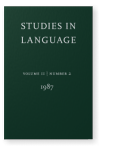Vol. 11:2 (1987) ► pp.401–434
Aktionsart, Semantics, and Function in the Japanese "Passive"
The Japanese "passive" construction with the verb stem formant -(r)are-has dual semantic functions. In some uses it indicates that the action's effects impinge emotively and/or psychologically on the subject, while in other uses the special effective nuance is absent. This distinction of semantic functions is shown to correlate with a distinction in the inherent aspectual character (Aktionsart) of verbally denoted actions, the deed/attribute distinction. A -(r)are- verb denoting a concrete action, or deed, implicates an abrupt change of circumstances having immediate effects on the subject's emotional and/or psychological situation; while processes and other nonconcrete actions, expressed through -(r)are-'s attributive use, implicate less immediate changes of the subject's state. In sum, the manner in which the action proceeds conditions the specific type of affect with which it is associated; both uses of -(r)are- are affective in distinct ways. These findings suggest the need to reconsider prior formal accounts of 'passive' -(r)are- constructions as rule-conditioned alternates of corresponding sentences without -(r)are-.
Cited by
Cited by 4 other publications
This list is based on CrossRef data as of 16 june 2024. Please note that it may not be complete. Sources presented here have been supplied by the respective publishers. Any errors therein should be reported to them.
